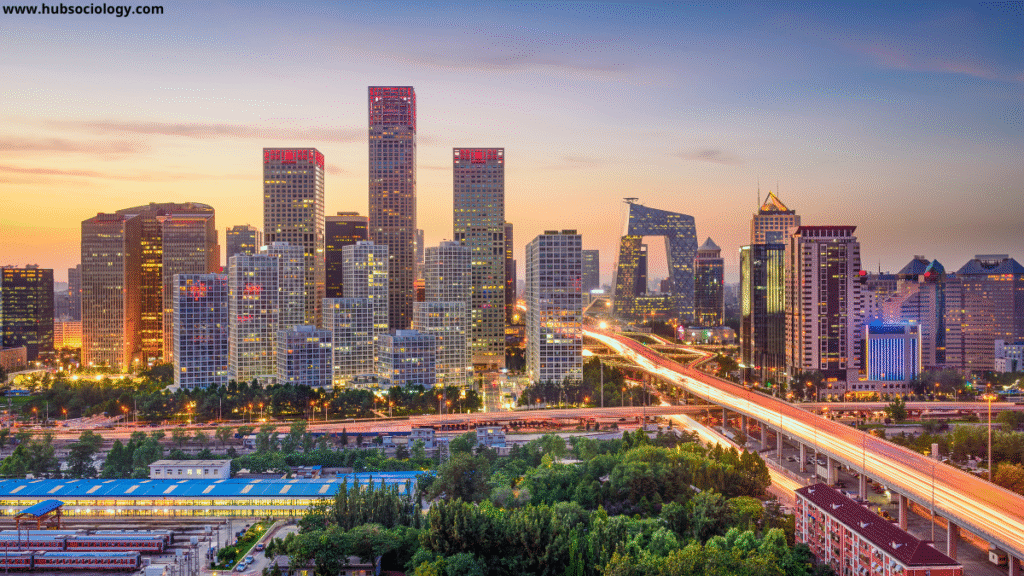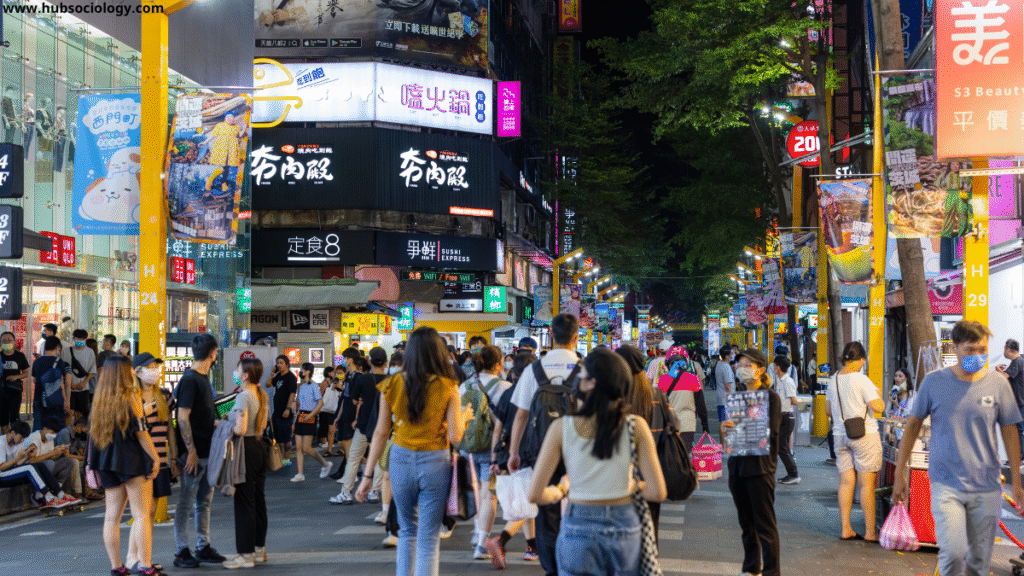Introduction
Over the last four decades, few social transformations have been as dramatic, rapid, and far-reaching as China’s urbanization. From a largely agrarian society in the 1970s, China has evolved into a nation where over 65% of the population now lives in cities. This unprecedented shift has led to the rise of mega-cities—urban centers with populations exceeding 10 million—such as Shanghai, Beijing, Guangzhou, Shenzhen, Chengdu, and Chongqing. These cities represent not just population hubs but complex social spaces where power, inequality, governance, culture, technology, and mobility intersect in transformative ways.
Sociologically, urbanization in China is more than demographic change. It reflects deeper processes shaped by state policy, economic restructuring, globalization, migration, and changing forms of family, community, and identity. This article analyzes China’s urban growth through a sociological lens, examining how mega-cities reshape everyday life, social hierarchies, cultural patterns, and political relations.

1. Historical Context: From Rural Socialism to Urban Reforms
China’s urbanization trajectory is deeply tied to the country’s political and economic reforms. Before 1978, the socialist model restricted rural-to-urban migration through the hukou (household registration) system, which divided citizens into “rural” and “urban” categories, limiting mobility and access to urban welfare.
With Deng Xiaoping’s reforms, China embraced industrialization, market expansion, and global integration. Cities became engines of growth through:
- Special Economic Zones (SEZs), especially in Shenzhen
- Export-oriented industries
- Infrastructure investment
- Rapid housing and land reforms
This shift created what sociologists call “compressed modernity”—a situation in which societies experience decades of transformation within a short time span. China’s urbanization compressed industrialization, globalization, and technological modernity into a few decades, producing intense social change.
2. The Rise of Mega-Cities: Economic and Spatial Dynamics
China now has some of the world’s largest and fastest-growing cities. Mega-cities like Shanghai and Beijing symbolize China’s entry into the global economy. Sociologically, the growth of mega-cities is shaped by economic clustering, migration, state planning, and spatial restructuring:
Economic Clustering
Mega-cities concentrate industries such as finance, technology, manufacturing, logistics, and cultural production. Shenzhen, once a fishing village, is now China’s “Silicon Valley,” demonstrating how urban spaces can rapidly change social and economic life.
Spatial Expansion
Urban sprawl, new towns, and high-rise developments have redefined city geographies. Sociologists observe how land transformation mirrors class changes: former rural villages become urban enclaves, and traditional neighborhoods are replaced by commercial complexes.
State-led Urban Development
Chinese urbanization differs from Western models because it is highly state-driven. Government planning plays a central role in determining:
- Land use
- Urban zoning
- Infrastructure investments
- Public housing policy
- Industrial distribution
Thus, mega-cities become embodiments of political-economic power, linking governance with everyday urban life.
3. Rural-to-Urban Migration: The New Working Class
The engine of China’s urban boom has been the migration of 290+ million rural residents who moved into cities for work. This phenomenon—one of the largest internal migrations in human history—has created a unique social class known as the “floating population” (liudong renkou).
Social Characteristics of Migrant Workers
- Limited access to public services due to hukou restrictions
- Concentration in low-wage sectors like construction, services, manufacturing
- Vulnerability in housing, healthcare, and education
- Formation of new migrant communities on the urban periphery
Sociologically, migrants are part of a dual urban system, where they contribute to urban prosperity but remain marginalized. This produces structural inequality, a major theme in Chinese urban sociology.
Changing Aspirations
New generations of migrants are more educated, socially aware, and ambitious. Known as “second-generation migrant workers,” they demand equal rights, better work conditions, and social inclusion.
4. Social Stratification and Inequality in Mega-Cities
Urban China is characterized by new forms of class differentiation. Sociologists note that mega-cities have produced:

1. Urban Middle Class
Highly educated, property-owning, technologically connected, and often benefiting from stable urban hukou status. They dominate jobs in:
- Tech
- Finance
- Education
- Government
They are key consumers in China’s growing market economy.
2. Urban Poor and Migrant Underclass
This group includes:
- Migrant workers
- Informal laborers
- Delivery workers
- Factory workers
They face challenges related to job security, rising living costs, and limited welfare benefits.
3. Elite Class
Composed of business leaders, political elites, real estate developers, and high-level professionals. They shape the urban landscape through capital-intensive development.
Spatial Inequality
Chinese mega-cities reveal clear divides:
- Urban core: Wealthy residents, high-end consumption
- Suburbs / peri-urban areas: Migrant enclaves
- Gated communities: Middle-class aspiration
- High-density rental units (“urban villages”): Migrant housing
This spatial stratification reflects deeper inequalities in income, power, and social status.
5. Housing and Real Estate: The New Social Currency
Housing is not just shelter—it is a major source of identity, class status, and family security in China.
Real Estate Boom
China’s urbanization produced a massive housing boom, making homeownership a key marker of:
- Middle-class membership
- Marriage eligibility (especially for men)
- Family stability
- Intergenerational wealth
However, soaring real estate prices in cities like Shenzhen or Shanghai create new class divides.
Urban Villages
Urban villages (chengzhongcun) are former rural areas absorbed into expanding cities. They are dense, low-cost spaces where millions of migrants live. Sociologists study them as hybrid spaces blending rural and urban life.
Displacement and Demolition
Redevelopment often leads to displacement of low-income populations, causing conflicts and protests. This highlights the tension between urban growth and social justice.
6. Family Structures and Everyday Life in Mega-Cities
Urbanization has changed traditional Chinese family life. The pressures of city living—long working hours, high housing costs, and competitive schooling—have reshaped family structures and aspirations.
Key Sociological Changes
- Decline in extended family systems
- Rise of nuclear families
- Increase in single-person households
- Delayed marriage and declining fertility
- Dual-working couples due to economic demands
Childhood and Education Pressures
Mega-cities have intense competition for schooling, leading to high educational stress. Parents invest heavily in:
- After-school programs
- Coaching centers
- Digital learning
This creates emotional and financial pressure that defines modern urban life.
7. Governance, Surveillance, and Smart Cities
China’s mega-cities are at the forefront of smart city innovations:
- AI-based monitoring
- Big data traffic management
- Digital payment ecosystems
- Smart grids
- Facial recognition systems
Sociologically, these technologies generate new questions about privacy, citizenship, power, and state-society relations.
Social Credit and Public Governance
While often misunderstood internationally, China’s social credit systems aim to regulate financial and civic behavior. However, sociologists debate its impacts on:
- Freedom
- Trust
- Compliance
- Surveillance
Urban residents experience both convenience and constraints under this governance model.
8. Cultural Change and Urban Identities
Mega-cities are spaces for cultural innovation and globalization. Young Chinese adopt new lifestyles influenced by:
- K-pop and J-pop
- Western fashion
- Digital gaming
- Coffee culture
- Creative arts and music
- Social media influencers
Urban life encourages individualism, a shift from traditional collectivist values. Meanwhile, cities become multicultural hubs, attracting international students, expatriates, and global companies.
9. Environmental Challenges and Urban Sustainability
Rapid urbanization has produced environmental challenges:
- Air pollution
- Water shortages
- Traffic congestion
- Waste management issues
- Loss of agricultural land
China now prioritizes eco-cities, public transport, renewable energy, and green buildings. Sociologically, environmental reforms reflect a growing public awareness of sustainable living.
10. Future of Urbanization: Toward a Network of City Clusters

China is shifting from mega-cities to mega-city regions or city clusters, such as:
- The Greater Bay Area (Guangzhou–Shenzhen–Hong Kong)
- The Yangtze River Delta (Shanghai–Hangzhou–Suzhou)
- The Beijing–Tianjin–Hebei (Jing-Jin-Ji) region
These clusters represent new spatial and economic strategies to balance development, reduce pressure on individual mega-cities, and promote integrated mobility.
Sociologists argue that China’s future urbanization will depend on:
- Inclusive policies for migrants
- Affordable housing reforms
- Sustainable growth
- Social welfare expansion
- Reducing inequality
- Encouraging community participation
Conclusion
China’s urbanization and the rise of mega-cities represent one of the most significant social transformations in modern history. These cities are not just population centers; they are living laboratories of modernization, where economic growth, technological innovation, cultural change, and social conflict intersect.
From rural-to-urban migration and class stratification to housing pressures and digital governance, the sociological dimensions of Chinese urbanization reveal both opportunities and contradictions. Mega-cities have improved living standards, expanded mobility, and created global networks. Yet they also produce new inequalities, spatial divisions, and governance challenges.
Understanding China’s mega-cities is essential not only for sociology but for global studies of urban development, as China’s experience continues to shape twenty-first century urbanization worldwide.
Do you like this this Article ? You Can follow as on :-
Facebook – https://www.facebook.com/hubsociology
WhatsApp Channel – https://whatsapp.com/channel/0029Vb6D8vGKWEKpJpu5QP0O
Gmail – hubsociology@gmail.com
Topic-Related Questions
5-Mark Questions
- Define urbanization and explain its relevance in the context of modern China.
- What is a mega-city? Give two examples from China.
- Briefly explain the hukou system and its role in China’s urbanization.
- Mention any two major impacts of rural-to-urban migration in Chinese cities.
- What is meant by “urban villages” in China?
- List two major environmental challenges caused by rapid urbanization in China.
- What are Special Economic Zones (SEZs) and how did they influence urban growth in China?
- Define the term “floating population” in Chinese sociological studies.
- What is meant by state-led urban development?
- Write two features of China’s smart city governance.
10-Mark Questions
- Discuss the sociological significance of the hukou system in shaping China’s urban-rural divide.
- Explain the role of migrant workers in the growth of Chinese mega-cities.
- Describe the rise of the middle class in China’s urban centers and its implication for social stratification.
- Analyze how rapid urbanization has transformed family structures and everyday life in Chinese mega-cities.
- Discuss the challenges of housing and real estate in China’s large cities.
- Evaluate the growth of smart cities in China and their impact on governance and surveillance.
- Explain the causes and consequences of spatial inequality in Chinese mega-cities.
- How does globalization influence cultural change in China’s urban areas?
- Discuss the emergence of city clusters in China and their sociological implications.
- Describe the social challenges faced by migrant communities living in urban villages.
15-Mark Questions
- Critically analyze China’s urbanization through the lens of sociological theories of modernization and inequality.
- Examine how economic restructuring and globalization contributed to the rise of mega-cities in China.
- Discuss the structural inequalities produced by China’s hukou system, with special reference to migrant workers in mega-cities.
- Evaluate the social, economic, and environmental impacts of China’s mega-city development model.
- Analyze the transformation of community, identity, and culture in Chinese mega-cities in the 21st century.
- Discuss the interplay between state planning, real estate markets, and social stratification in China’s urbanization.
- Explain the sociological significance of technology-driven governance (AI, big data, surveillance) in modern Chinese cities.
- Assess how rural-to-urban migration reshapes class structure and social mobility in China.
- Examine the changing family patterns in mega-cities and their implications for gender, work, and education.
- Discuss the future of China’s urbanization with reference to sustainability, inclusiveness, and mega-city clusters.
